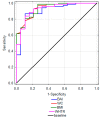Sensitivity and Specificity of Anthropometric Indices in Identifying Obesity in Women over 40 Years of Age and Their Variability in Subsequent Decades of Life
- PMID: 36552313
- PMCID: PMC9775391
- DOI: 10.3390/biology11121804
Sensitivity and Specificity of Anthropometric Indices in Identifying Obesity in Women over 40 Years of Age and Their Variability in Subsequent Decades of Life
Abstract
Anthropometric measurements and indices are a simple and inexpensive method to assess normal physical development and quickly identify the risk of diseases. The aim of the study was to verify the sensitivity (Se) and specificity (Sp) of selected anthropometric indices in a group of women over 40 years. The study included 87 women (group I-40 to 49 years, group II-50 to 59 years, group III-60 to 69 years, and group IV-70 to 79 years). Anthropometric characteristics were measured: body mass (BM), body height (BH), waist circumference (WC), and hip circumference (HC). Body mass index (BMI), body adiposity index (BAI), waist-hip ratio (WHR), and waist-to-height ratio (WHTR) were calculated. The percentage of fat tissue (FT) and visceral fat volume (FV) were evaluated using DEXA. A decrease in mean BH with an increase in the mean WC, WHR, and WHTR in subsequent decades. There were strong statistically significant correlations between FT and most indicators (except for WHR). FV was correlated at a strong or moderate level with most parameters. In the group of women aged 40 to 80 years, the most favorable AUC was obtained for WC, followed by BMI. BAI can be recommended as a complementary indicator to BMI.
Keywords: 40+; anthropometric indices; body mass index; obesity; women.
Conflict of interest statement
The funders had no role in the design of the study; in the collection, analyses, or interpretation of data; in the writing of the manuscript; or in the decision to publish the results.
Figures
Similar articles
-
Determining the best method for evaluating obesity and the risk for non-communicable diseases in women of childbearing age by measuring the body mass index, waist circumference, waist-to-hip ratio, waist-to-height ratio, A Body Shape Index, and hip index.Nutrition. 2023 Oct;114:112135. doi: 10.1016/j.nut.2023.112135. Epub 2023 Jun 16. Nutrition. 2023. PMID: 37453224
-
Degree of association between the body mass index (BMI), waist-hip ratio (WHR), waist-height ratio (WHtR), body adiposity index (BAI) and conicity index (CI) in physically active older adults.Clin Nutr ESPEN. 2023 Dec;58:335-341. doi: 10.1016/j.clnesp.2023.10.007. Epub 2023 Oct 14. Clin Nutr ESPEN. 2023. PMID: 38057024
-
Comparative analysis of anthropometric indices of obesity as correlates and potential predictors of risk for hypertension and prehypertension in a population in Nigeria.Cardiovasc J Afr. 2017 Mar/Apr 23;28(2):92-99. doi: 10.5830/CVJA-2016-061. Epub 2016 Jul 13. Cardiovasc J Afr. 2017. PMID: 27701484 Free PMC article.
-
Comparison of adiposity anthropometric indices and their associations with visceral fat levels determined by bioelectrical impedance analysis among diabetic patients.Sci Rep. 2022 Oct 24;12(1):17824. doi: 10.1038/s41598-022-22848-z. Sci Rep. 2022. PMID: 36280694 Free PMC article.
-
Cutoff points of adiposity anthropometric indices for low muscle mass screening in middle-aged and older healthy women.BMC Musculoskelet Disord. 2021 Aug 20;22(1):713. doi: 10.1186/s12891-021-04532-x. BMC Musculoskelet Disord. 2021. PMID: 34416881 Free PMC article.
Cited by
-
Sex-specific adverse effects of lipid accumulation products and cardiometabolic indices on the prevalence of gallstones: insights from the 2017-2020 national health and nutrition examination survey.BMC Gastroenterol. 2025 Jul 22;25(1):529. doi: 10.1186/s12876-025-04099-0. BMC Gastroenterol. 2025. PMID: 40696316 Free PMC article.
-
The association between ten anthropometric measures and osteoporosis and osteopenia among postmenopausal women.Sci Rep. 2025 Mar 31;15(1):10994. doi: 10.1038/s41598-025-94218-4. Sci Rep. 2025. PMID: 40164628 Free PMC article.
-
Association between novel anthropometric indices and overactive bladder: a population-based study.Front Nutr. 2025 Jan 22;12:1493792. doi: 10.3389/fnut.2025.1493792. eCollection 2025. Front Nutr. 2025. PMID: 39911808 Free PMC article.
-
Comparison of body adiposity index and body mass index for assessment of body fat percentage among office workers: A validation study.Pak J Med Sci. 2025 Jun;41(6):1677-1682. doi: 10.12669/pjms.41.6.11630. Pak J Med Sci. 2025. PMID: 40621542 Free PMC article.
-
Association of cardiometabolic index with gallstone disease and insulin resistance based on NHANES data.BMC Gastroenterol. 2025 May 9;25(1):354. doi: 10.1186/s12876-025-03950-8. BMC Gastroenterol. 2025. PMID: 40346457 Free PMC article.
References
-
- NCD Risk Factor Collaboration (NCD-RisC) Worldwide trends in body-mass index, underweight, overweight, and obesity from 1975 to 2016: A pooled analysis of 2416 population-based measurement studies in 128·9 million children, adolescents, and adults. Lancet. 2017;390:2627–2642. doi: 10.1016/S0140-6736(17)32129-3. - DOI - PMC - PubMed
Grants and funding
LinkOut - more resources
Full Text Sources



